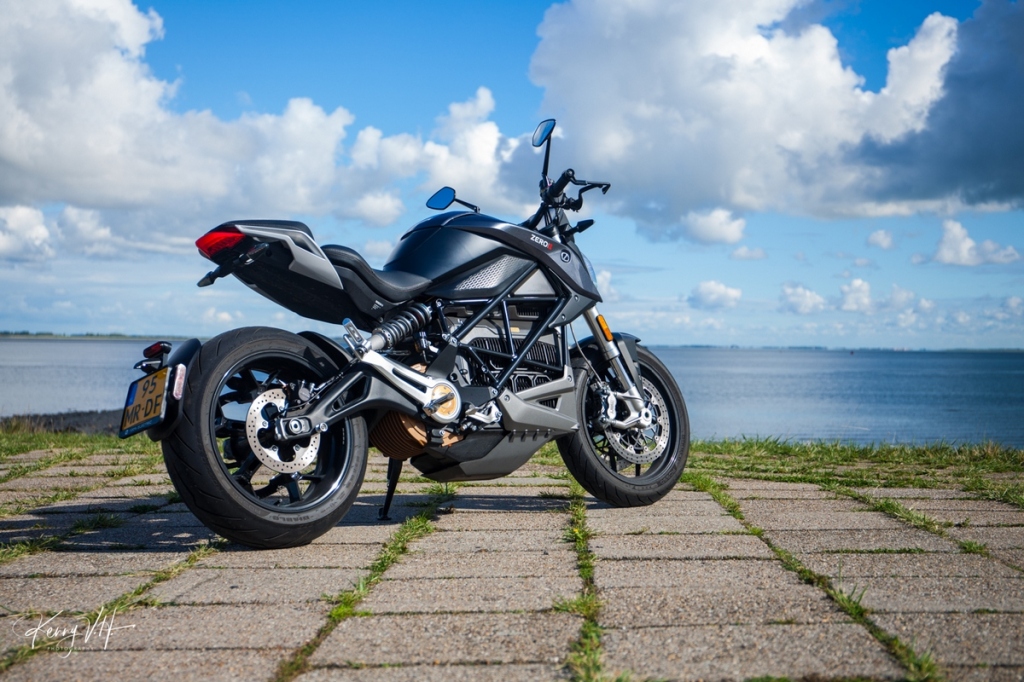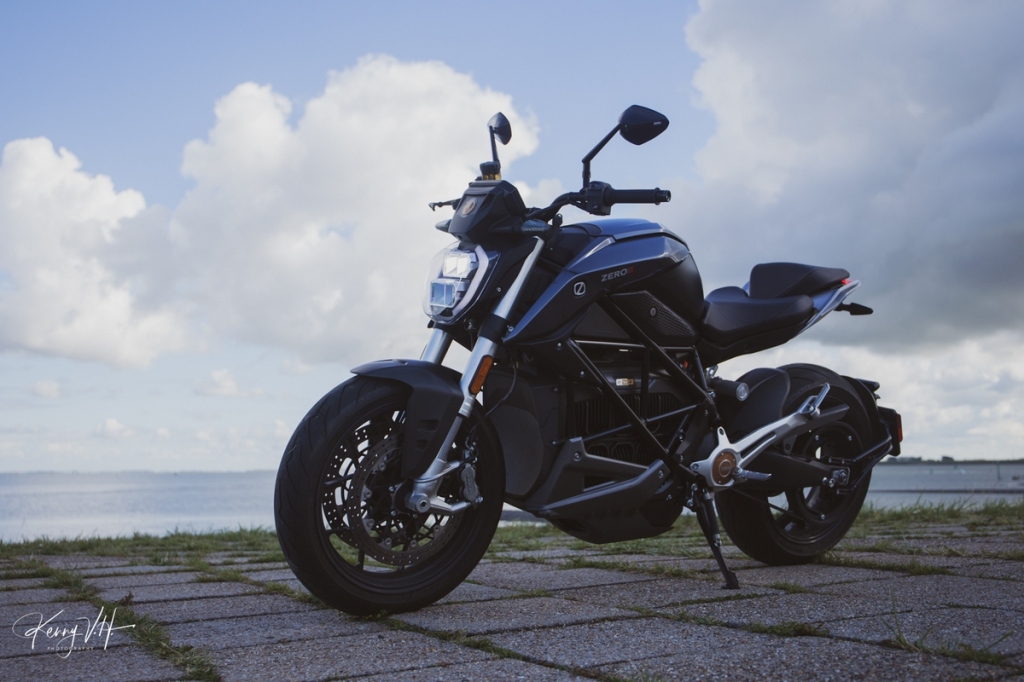Just to be complete: I tested the Zero SR 14.4+ ZF75-10 MY 2022.
You can’t get past the electrification of cars nowadays. This year for example, I traded in my diesel-guzzling company car for a PHEV model. Electric motorcycles, on the other hand, are pretty much a rare sight. But the past EICMA made it clear that they are on their way. A few major manufacturers presented their vision of the future, which is often electric. With the Zero SR I was able to test such a combustion-free bike.

Founded in 2006 in California, Zero has been the reference within the electric segment for years. The SR I tested is a model year 2022, equipped with the well known 14.4+ ZF75-10 power source. Important detail: the 2023 model has some important upgrades. More on that later.
The lithium-ion battery with a capacity of 14.4 kWh powers a patented Z-Force motor that produces 166 Nm of torque and 75 hp. The plus sign in the name indicates that the battery pack can optionally be expanded to 17.3 kWh.

The battery is ultimately what this motorcycle is all about. The key question everyone asked me: how far can you ride it? According to Zero between 124 km on the highway (at 113 km/h) and 251 km in the city. I never made it that far. With an easygoing riding style, never exceeding 100 km/h, 160 km was possible.
Second most asked question: how long does it take to charge? From a normal socket about 4.5 hours for a full charge. Fast charging is not an option with the base model.
And question three: what does charging actually cost? I don’t normally care about fuel consumption on a motorcycle, but it’s not an irrelevant factor when considering an electric motorcycle.
Follow along: a realistic range of 160 km with a battery (with a usable capacity) of 12.6 kWh gives 7.9 kWh/100 km. At the time of testing, my night rate cost € 0.25/kWh. That gives just under € 2.00/100 km. At the same time, E10 petrol cost € 1.76/l, and with an (imaginary and realistic) consumption of 6 l/100 km, this would correspond to a cost of € 10.00/100 km. Quite the difference! In addition, apart from the costs of charging, tires and brake pads, a Zero has hardly any maintenance costs.

So much for the boring part, time to ride. I plan a ride of 155 km of cornering pleasure in the South of Belgium, together with a group of speed lovers. I just have to solve two problems before leaving.
Number one: the one-way ride to the meeting point is 160 km from where I live. So it’s no option to ride there and then start charging for 4.5 hours. Solution: I’ll put the Zero on the trailer, so I can appear at the start with a full battery.
Second dealbreaker: even with a full battery I can’t finish the planned 155 km ride, because those speed lovers keep a brisk pace. I adjust the route a bit and make some cut-offs to end up around 140 km. That should work. Well, not really, because unannounced, heavy rain throws a spanner in the works, and we decide to cancel the ride.

Just to say: last minute decisions to do a long ride isn’t an option with the Zero. Charging on the go, especially with the standard version, takes too long. And you also have to drag the heavy charging cable along. Fortunately, it fits in the handy “trunk space”, where you normally find the gas tank. However, if you opt for the larger battery or the fast charging option, you will lose that space. And finding a nice stop-over with a socket within reach isn’t easy either.

Luckily, there are nice curvy roads closer to home. The Zero certainly feels in its comfort zone there. Despite a weight of 227 kg, it’s very manoeuvrable and the seat height of only 79 cm contributes to its accessibility. The fully adjustable Showa suspension and J.Juan brakes are up to par, although the ABS intervenes a little too quickly under hard braking. This can probably be solved by adjusting the suspension.
Hard braking is necessary: the SR is a rocket in Sport mode. It’s known that with an electric engine the torque is instantaneously available, and I was able to experience that first hand. The awe-inspiring reprises provide a big adrenaline rush. Turning the throttle full-on time and time again drains the battery in no time, but it’s great fun.

What contributes to that fun: everything goes effortlessly. You don’t have to worry about whether you’re in the right gear, and your left hand is only needed to grip the handle bars or operate the menu button.
In the menu you can choose between the different mappings: Rain, Eco, Street and Sport. Each mapping clearly has its own character. The most fun one is Sport, the most realistic is Street: acceleration is just a little bit slower, the top speed remains the same at 167 km/h and the range becomes acceptable in this mode.

Via the Cypher III connected operating system you can set the riding mode on your smartphone. Your right hand can also rest occasionally, cruise control is standard. It’s one of the minimalist type: you can only choose the speed, increasing or decreasing speed while riding is not possible.

If you ride into a city, you will notice how relaxing a ride on the SR is. The lack of an exhaust sound certainly contributes to this. At first it made me feel a bit invisible, but actually cars move just as smoothly as on a “normal” bike. Loud pipes don’t save lives, and here’s your proof. I liked the silence. You hear much better what’s going on and the futuristic, humming sound of the Zero gives you the feeling of being on the road with a bike from a sci-fi movie.
As easy, confidence-inspiring and self-evident as the SR rides, after a while I missed the character of a geared, petrol-burning and loud motorcycle. Ultimately, I would like to be able to choose whether I take a corner in high revs in second gear, or lazily in fourth through the same corner. With the SR, that choice fades and the riding experience becomes a bit soulless. The fact that you get off fit as a fiddle after a 150 km ride is a nice bonus though.

Conclusion
With the Zero SR I had mixed feelings from the start, and that feeling lasted all week. Zero equips this bike with quality parts used by every other premium brand (Showa suspension, J.Juan brakes, Pirelli Rosso III tyres), it’s the most connected motorcycle I’ve ever ridden, and its performance, speed sensations and handling are similar to that of a 750 cc naked bike, with the Zero also offering tons of confidence and ease of riding. But the finish could be better, the menu lacks the intuitiveness of BMW or KTM and the SR simply doesn’t have the tons of character that a typical three-quarter liter hooligan bike does have.
I don’t associate charging anxiety with the feeling I want to get from motorcycling: freedom, taking a last-minute ride (preferably far away) or spending a day riding with some biker friends. More often than I liked, I had to break off a nice ride to get to a socket in time.
I’d like to make it clear that this feeling is very personal. If you commute daily over a shorter distance, when the range is less important or you can charge during the day, then an electric motorcycle is ideal. Get on it, choose the riding mode of the day and off you go. You’ll get addictive accelerations and will arrive at your destination so smoothly and relaxed as with no other motorcycle.
Just make sure you can factor in the costs: for the price of one Zero SR you buy two of the aforementioned 750 cc naked bikes. As standard, the 2022 SR starts at £23,995. If you want a 6kW Rapid Charger, there will be an additional £2,459 and you will pay an extra £2,899 for the Power tank. Combining the Rapid Charger with the Power tank isn’t possible by the way.
Photography: Kenny van Houttave
Note:
We can’t predict what the future brings. One thing however is pretty certain: electric motorcycles are coming. Zero works hard to make the usability of its models accessible to a wider audience. Our model year 2022 test model is no longer available. For 2023, Zero offers a larger capacity of 15.7 kWh on the SR as standard and you can still opt for more battery capacity or faster charging. Both power and range increase significantly in the 2023 model and thus address the main points of criticism. The Cypher III+ operating system becomes even more complete and allows you to really control everything via your smartphone. Configuring your ideal Zero isn’t easy, so let your dealer inform you about the possibilities.
Pros
+ Accelerations in Sport mode are addictive
+ Ease of use
+ Electric motorcycles are the future, riding them feels futuristic
Cons
– Battery range remains on the low side
– Charging stress
– Price
Tech specs
These are the specs of a ZF15.6+
Range
City : 169 miles (272 km)
Highway, 55 mph (89 km/h) : 103 miles (166 km)
Combined : 128 miles (206 km)
Highway, 70 mph (113 km/h) : 84 miles (135 km)
Combined : 112 miles (180 km)
EU Regulation 134/2014, Annex VII: 102 miles (164 km)
With Extended Range Charging (ERC) Cypher Upgrade (17.3 kWh): 114 miles (183 km)
Engine
Peak torque: 122 ft-lb (166 Nm)
Peak power : 74 hp (55 kW) @ 6,255 rpm
Continuous power : 54 hp (40 kW) @ 5.000 rpm
Required licence : Full A licence
Top speed (max) : 104 mph (167 km/h)
Top speed (sustained) : 104 mph (167 km/h)
Type: Z-Force 75-10 enhanced thermal efficiency, passively air-cooled, interior permanent magnet AC motor
Controller: High efficiency and power dense, 750 Amp, 3-phase AC controller with regenerative deceleration
Power system
Power pack: Z-Force Li-Ion intelligent integrated
Max capacity: 15.6 kWh
Nominal capacity: 13.7 kWh
Charger type: 3kW integrated
Charge time (standard): 4.8 hours (100% charged) / 4.3 hours (95% charged)
With 6kW Rapid Charger: 1.9 hours (100% charged) / 1.4 hours (95% charged)
Drivetrain
Transmission: Clutchless direct drive
Final drive: 90T / 20T, Poly Chain® HTD® Carbon™ belt
Chassis / Suspension / Brakes
Front suspension: Showa 43mm Big Piston Separate Function forks, with adjustable spring preload, compression & rebound damping
Rear suspension: Showa 40mm piston, piggy-back reservoir shock with adjustable spring preload, compression & rebound damping
Front suspension travel : 4.72 in (120 mm)
Rear suspension travel : 5.51 in (140 mm)
Front brakes: Bosch Base MSC, dual J-Juan radial 4-piston calipers with radial master cylinder, 320x5mm discs
Rear brakes: Bosch Base MSC, J-Juan single piston floating caliper, 240×4.5mm disc
Front tire: Pirelli Diablo Rosso III 120/70-17
Rear tire: Pirelli Diablo Rosso III 180/55-17
Front wheel: 3.50 x 17
Rear wheel: 5.50 x 17
Dimensions
Wheelbase : 57.1 in (1,450 mm)
Seat height : 31.0 in (787 mm)
Accessory, low: 30.3 in (770 mm)
Accessory, tall: 31.9 in (810 mm)
Rake: 24.5°
Trail: 3.7 in (94 mm)
Weight
Curb weight: 489 lb (222 kg)
Carrying capacity: 511 lb (232 kg)